Powerful earthquake turns Turkish olive grove into giant canyon
Incredible drone footage shows an olive grove split in two after last week’s devastating earthquake in Turkey and Syria as the death toll exceeds 41,000. Watch video.
World
Don't miss out on the headlines from World. Followed categories will be added to My News.
An olive grove has been split in two by powerful earthquakes that devastated parts of Turkey and Syria, leaving a 1.5 mile canyon in its wake.
Drone footage shows the level of destruction in the small town of Tepehan in rural eastern Turkey, where the grove was bisected.
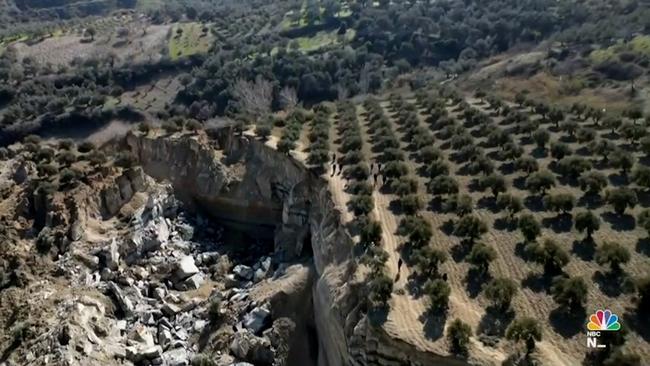
The town is near the East Anatolian Fault line responsible for last week’s tremors – Turkey’s deadliest ever. The quakes also devastated neighbouring Syria.
More than 41,000 people have been killed in both countries and officials say the number is likely to rise.
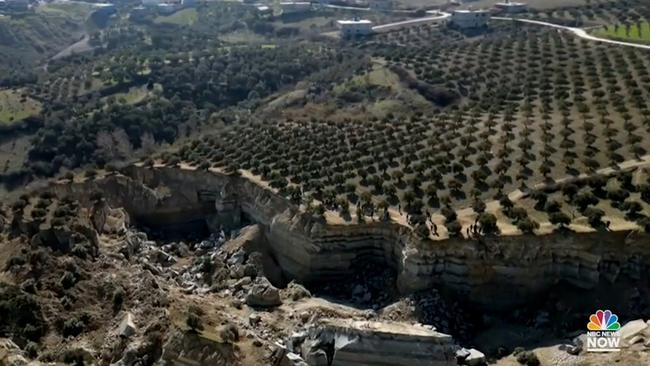
The destruction revealed in the video is testament to the intensity and power of mother nature.
The transformation of the landscape is so significant, people from nearby villages are making their way over to the site to view the newly-formed cliffs, some of which are still crumbling.
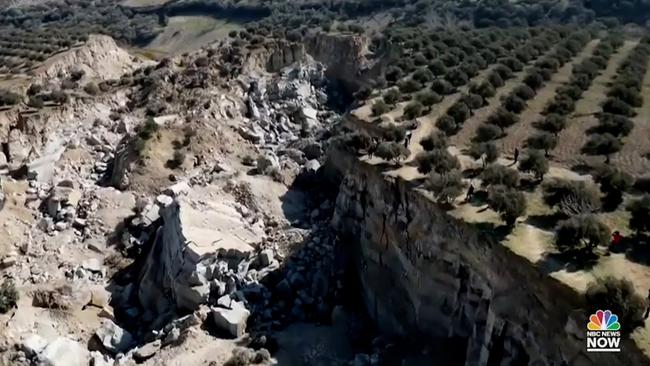
PEOPLE FOUND ALIVE UNDER RUBBLE
As the staggering death toll from the earthquake that rocked Turkey and Syira surpasses 41,000, miraculous tales of survival continue to emerge from the devastated regions nine days after the tragedy struck.
On Wednesday, rescuers were still pulling people from the rubble, defying predictions that the time for survival had passed.
A 74-year-old woman identified as Cemile Kekec was found alive in the rubble of a building almost 226 hours in the southern Turkish city of Kahramanmaras, on Wednesday. A video posted on social media showed her being put on a stretcher and taken to an ambulance as workers around her rejoiced, Reuters reported.
#Breaking A 74-year-old woman has been rescued ALIVE in #Kahramanmaraş after ten days under the rubble, that’s 226 hours! Her name is Cemile Kekeç (IHA) pic.twitter.com/oWEI0nAFtw
— Maria Ramos (@MariaRamosUK) February 15, 2023
Another clip aired on local television showed rescue workers carrying, Melike Imamoglu, 42, on a stretcher and placing her in an ambulance on Wednesday morning. She was reportedly rescued after 222 hours trapped in rubble of a collapsed building in Kahramanmaras, according to Turkey’s state television TRT Haber.
Turkey’s Ministry of National Defense also released footage showing rescuers extricating a 77-year-old woman from debris in the city of Adiyaman on Tuesday, some 212 hours after the earthquake struck.
Turkey’s state-run news agency Anadolu identified her as Fatma Gungor, and said her family hugged her after she was saved.
A 15-year-old Syrian girl, Seher, was also saved in Hatay, Turkey, after 210 hours.
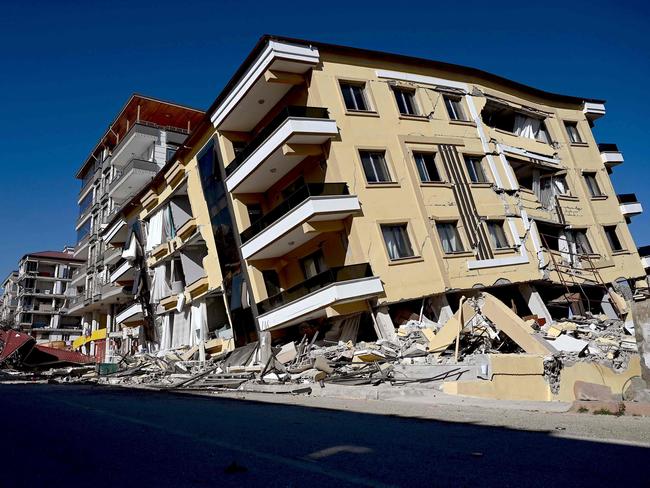
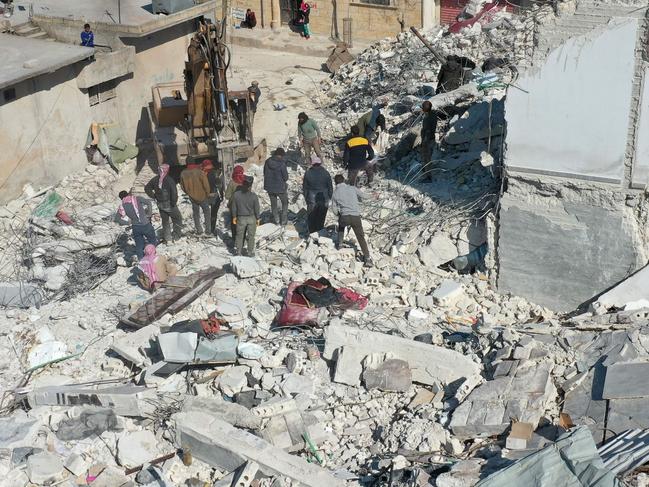
VOICES STILL HEARD UNDER RUBBLE ONE WEEK ON FROM QUAKE
The catastrophic earthquake, the epicentre of which was in Turkey, constitutes the “worst natural disaster” in 100 years in its Europe region, the World Health Organisation said on Tuesday.
The 7.8-magnitude earthquake, followed by a major aftershock, on February 6 has now killed more than 41,200 people in Turkey and neighbouring Syria.
“We are witnessing the worst natural disaster in the WHO European region for a century and we are still learning about its magnitude,” Hans Kluge, WHO regional director for Europe, told a press conference.
The WHO’s European region comprises 53 countries, including Turkey. Syria is a member of the WHO’s neighbouring Eastern Mediterranean region.
Mr Kluge also said the health body had “initiated the largest deployment of emergency medical teams” in the 75-year history of the WHO European region.
“Twenty-two emergency medical teams have arrived in Turkey so far,” Mr Kluge noted, adding they would integrate into “Turkey’s ongoing health response”.

The toll has barely changed in Syria for several days but is expected to rise.
“The needs are huge, increasing by the hour. Some 26 million people across both countries need humanitarian assistance,” Mr Kluge said.
Rescue teams in southern Turkey have reported that they are still hearing voices from under the rubble more than a week after the devastating quake struck.
A handful of survivors have continued to be pulled from the rubble, including four on Tuesday, defying belief almost 200 hours after the disaster.
However, keeping them alive after being buried for so long is a battle. “It’s a miracle to find a patient still alive under the rubble,” doctor Yilmaz Aydin told AFP.
“From now on, the survivors are likely to be in a more critical condition. The majority of them will need lifesaving treatment,” said Aydin.
One survivor was 25-year-old Syrian woman Abir, who spent 180 hours trapped under the rubble.
“Her heart stopped two times but we managed to bring her back,” said doctor Nihat Mujdat Hokenek.
Another survivor, a small dog, was pulled alive from rubble in Samandag, in Turkey’s Hatay Province, on Tuesday, more than a week after deadly earthquake struck.
On the same day, rescue workers in the Kahramanmaras region were trying to save three sisters believed to be buried under the debris.
In the same region, emergency workers saved a 35-year-old woman who was believed to have been buried for around 205 hours, according to state broadcaster TRT Haber.
Two brothers – 17-year-old Muhammed Enes Yeninar and 21-year-old brother Abdulbaki Yennir – were also pulled from collapsed buildings on Tuesday, the broadcaster also reported.
In Antakya, Turkey, there was cheers as a 15-year-old boy was rescued alive from rubble.
Further east, in the city of Adiyaman, rescuers pulled an 18-year-old boy and a man alive from the rubble, while Ukraine’s rescue team pulled a woman alive out of the rubble in the southern province of Hatay, according to CNN Turk.
PRESIDENT BOASTED ABOUT LETTING BUILDERS AVOID QUAKE CODES
Turkish President Recep Tayyip Erdogan is in the firing line after videos were unearthed by local media showing him hailing some of the residential towers that collapsed in this month’s deadly 7.8 magnitude quake.
It comes as dozens of arrest warrants have been issued for property developers who have been identified as responsible for the collapse of buildings.
In one video taken ahead of Turkey’s March 2019 elections, Mr Erdogan cites new housing for the city of Kahramanmaras, also referred to as Maras, near the epicentre of last week’s quake, as one of his government’s major achievements.

“We solved the problem of 144,156 citizens of Maras with zoning amnesty,” Erdogan said, referring to construction amnesties allowing contractors to skip safety codes to make apartment blocks, houses and office buildings more resistant to earthquakes.
In another 2019 campaign stop, in the Hatay province, Mr Erdogan said of a housing project:
“We have solved the problems of 205,000 citizens of Hatay with zoning peace,” again using another term for construction amnesties.
Turkish news site Duvar, citing a senior Istanbul official named Budgra Gokce, reported listed tens of thousands of building amnesty certificates granted before the 2018 general election in 10 provinces struck by the earthquake.
Local media reports the amnesty meant that some builders had to pay a fine but their construction projects could go ahead if they didn’t meet code restrictions.
MIRACLE QUAKE RESCUES AS SEARCH EFFORTS WIND DOWN
Australian search and rescuers have arrived in Turkey as part of an international mission to locate survivors of the devastating earthquakes.
The Disaster Assistance Response Team arrived in the Hatay Province on Sunday evening (local time) and has established an operational base at Antakya.
The Aussies are expected to be in the region for about a fortnight.
A woman was rescued after 175 hours under the rubble, as workers in Turkey continue to search for survivors.
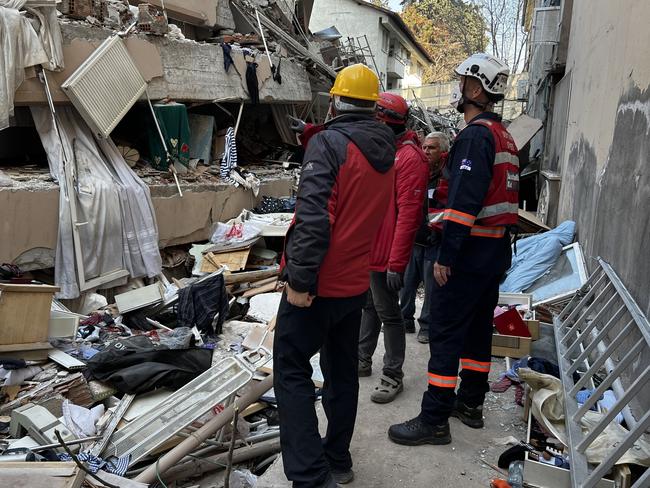
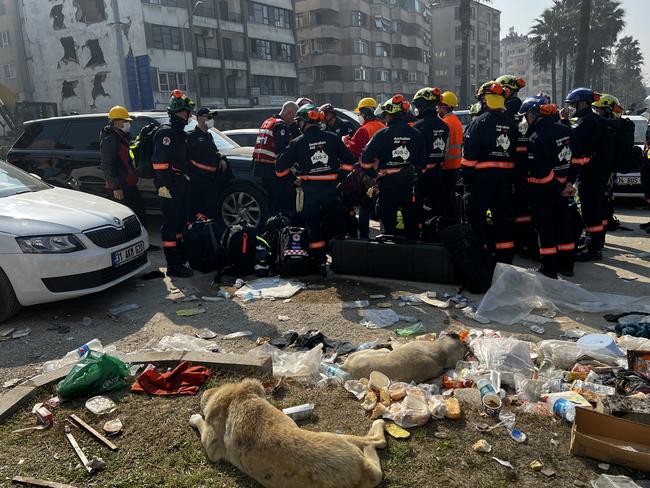
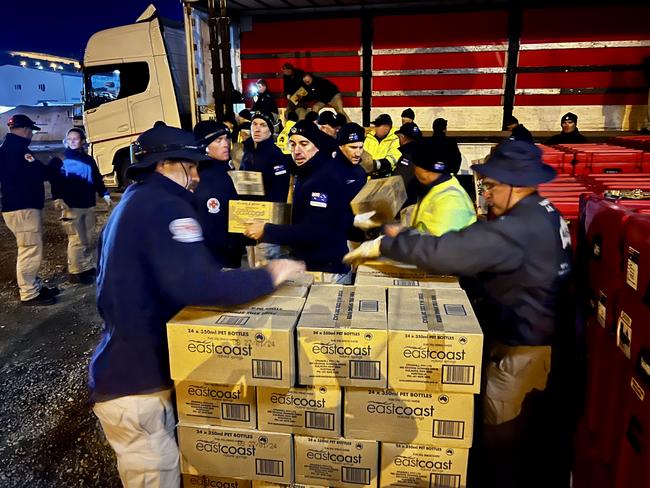
Eight days after the devastating tremor, Turkish media reported a handful of people were still being pulled from the rubble as excavators dug through ruined cities.
However, rescue operations are over in rebel-held areas of northwest Syria, the White Helmets volunteer organisation said, where relief efforts have been stymied by a long-running civil war.

Rescue teams are starting to wind down the search for survivors and the aid effort has now shifted to the hundreds of thousands of people who have been made homeless by the devastating.
The United Nations has decried the failure to ship desperately needed aid to war-torn regions of Syria and warned that the toll is set to rise even higher as experts caution that hopes for finding people alive dim with each passing day.
“Send any stuff you can because there are millions of people here and they all need to be fed,” Turkish Interior Minister Suleyman Soylu appealed to Turks late Sunday.
In Kahramanmaras, close to the epicentre, 30,000 tents have been installed, 48,000 people are sheltering in schools and another 11,500 in sports halls, he said.
While hundreds of rescue teams were still working, efforts had ended in seven parts of the province, he added.
MIRACLE RESCUES AFTER A WEEK
A young boy and a 62-year-old woman were the latest miracle rescues after nearly seven days trapped under the wreckage of collapsed buildings since last Monday’s devastating quake.
Seven-year-old Mustafa was rescued in southeast Turkey’s Hatay province while Nafize Yilmaz was pulled free in Nurdagi, also in Hatay, the Anadolu state news agency reported early Monday. Both had been trapped for 163 hours before their rescue late Sunday.
Turkey’s disaster agency said more than 32,000 people from Turkish organisations were working on search-and-rescue efforts, along with 8,294 international rescuers.
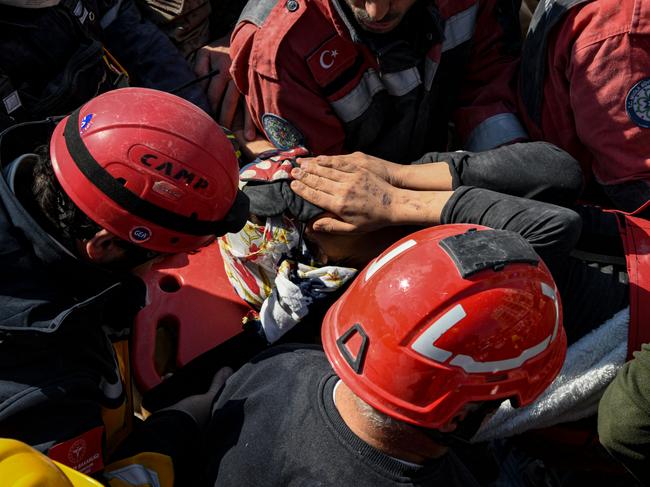

A member of a British search team posted a remarkable video on Twitter on Sunday showing a rescuer crawling down a tunnel created through the rubble to find a Turkish man who had been trapped for five days in Hatay.
Search teams are facing a race against the clock as experts caution that hopes for finding people alive in the debris dim with each passing day.
In the devastated Turkish city of Kahramanmaras, near the epicentre of the quake, excavators dug through mountains of twisted rubble as a rescue team recovered a body from the wreckage.
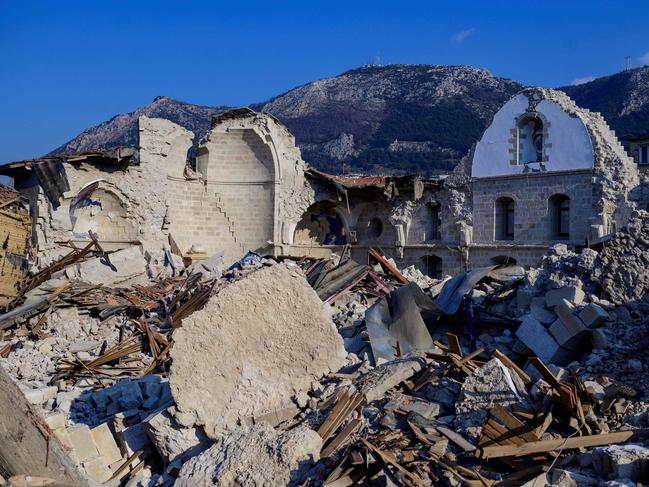
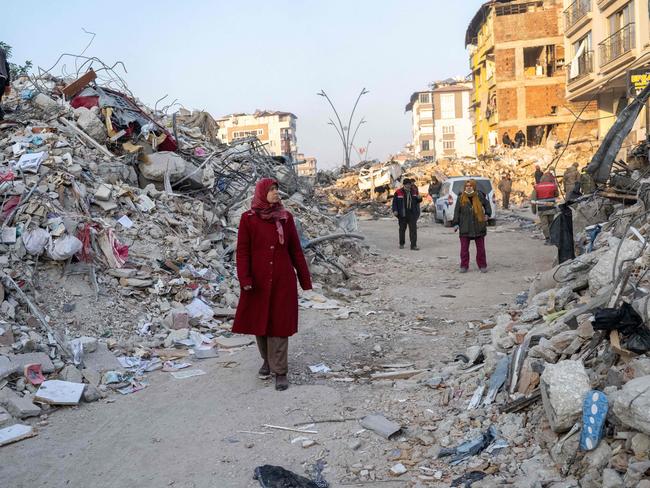
But in many areas, rescue teams said they lacked sensors and advanced search equipment, leaving them reduced to carefully digging through the rubble with shovels or only their hands.
“If we had this kind of equipment, we would have saved hundreds of lives, if not more,” said Alaa Moubarak, head of civil defence in Jableh, northwest Syria.
Officials and medics said 29,605 people had died in Turkey and 3,581 in Syria from last Monday’s 7.8-magnitude quake, bringing the confirmed total to 33,186.
ARREST WARRANTS FOR BUILDERS IN TURKEY
More than 130 arrest warrants have been issued for property developers who have been identified as responsible for the collapse of buildings following the earthquake in Turkey.
It came as the United Nations warned that the whopping death toll could double, and denounced a failure to get desperately needed aid to some of the affected regions.

Turkish Vice President Fuat Oktay said that 131 suspects were responsible for the collapse of buildings in the 10 provinces affected by last Monday’s tremors.
Already 12 people have been taken into custody by Turkish police, with the undress disrupting rescue efforts in some areas.
“Detention orders have been issued for 113 of them,” he said.
“We will follow this up meticulously until the necessary judicial process is concluded, especially for buildings that suffered heavy damage and buildings that caused deaths and injuries.”
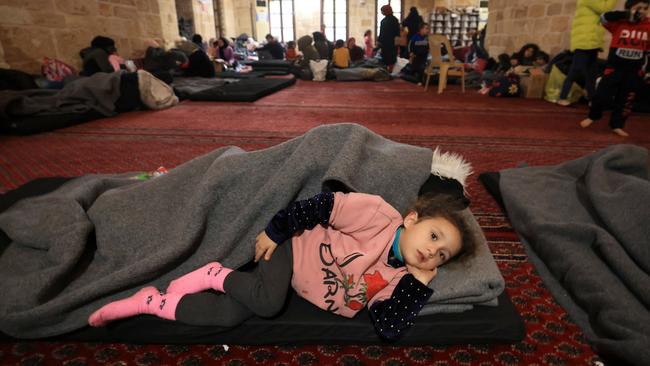
One video footage shows the moment Mehmet Yasar Coskun, the contractor of the Ronesans Residence block which collapsed in Antakya, was arrested at Istanbul airport on Friday.
A second developer Mehmet Ertan Akay – the property developer of the Ayşe Mehmet Polat apartment complex which collapsed in the city of Gaziantep – was detained on Saturday.
One of the detained contractors, Yavuz Karakus, told reporters: “My conscience is clear. I built 44 buildings. Four of them were demolished. I did everything according to the rules.
Experts have been warning for years that many new buildings in Turkey were unsafe due to endemic corruption and government policies.
According to the BBC, those policies allowed so-called amnesties for contractors who swerved building regulations, in order to encourage a construction boom — even in earthquake-prone regions.
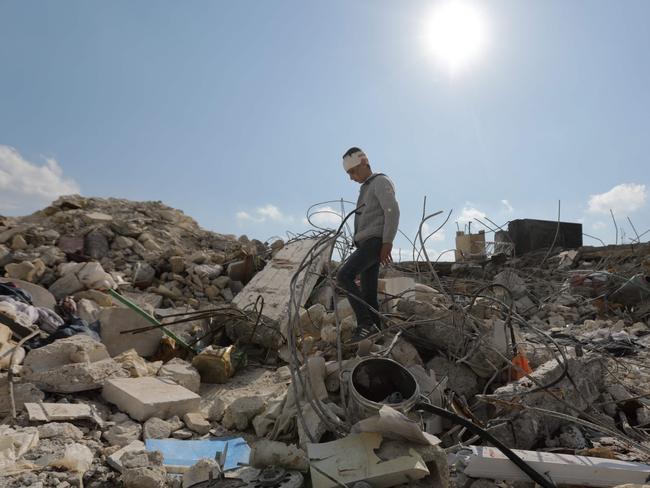
FOOTAGE SHOWS QUAKE DAMAGE TO EARTH
Dramatic drone footage has shown the staggering scale of destruction in the earth’s crust that was left behind by the devastating earthquake.
The video shows entire fields covered in debris as a massive deep chasm now lies between them, as the 7.8 magnitude quake moves Turkey up to three feet towards the west.
Almost 26 million people have been affected by the earthquake, the World Health Organisation (WHO) said as it appealed Saturday for $US42.8 million ($A61.8m) to cope with immediate health needs after dozens of hospitals were damaged.
In Syria alone, up to 5.3 million people may have been made homeless.
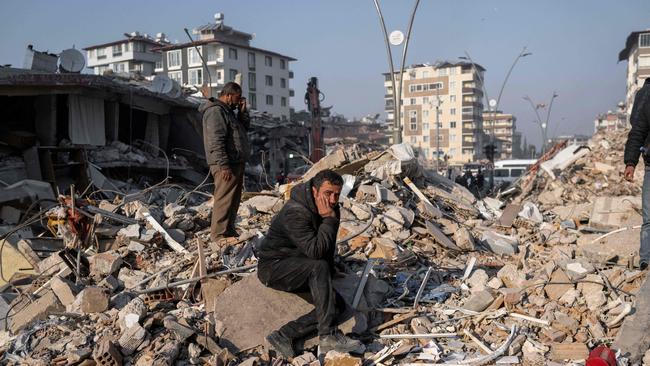
A UN convoy with supplies for northwest Syria arrived via Turkey, but the agency’s relief chief Martin Griffiths said much more was needed for millions whose homes were destroyed.
“We have so far failed the people in northwest Syria. They rightly feel abandoned. Looking for international help that hasn’t arrived,” Mr Griffiths said on Twitter.
Supplies have been slow to arrive in Syria, where years of conflict have ravaged the healthcare system, and parts of the country remain under the control of rebels battling the government of President Bashar al-Assad, which is under Western sanctions.
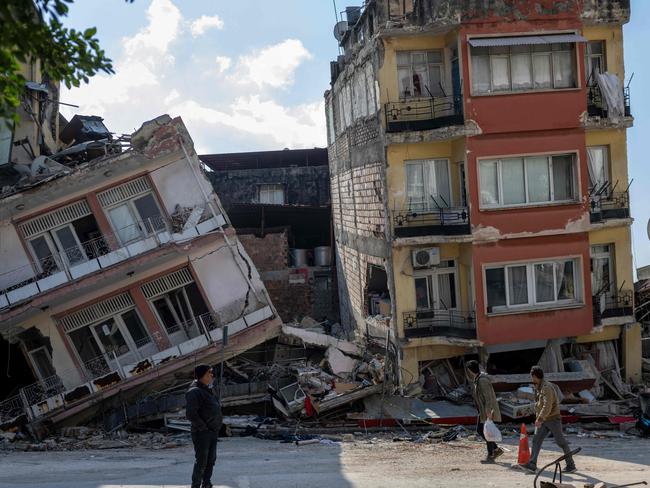
The UN convoy of ten trucks crossed into northwest Syria via the Bab al-Hawa border crossing, according to reports.
Bab al-Hawa is the only point for international aid to reach people in rebel-held areas of Syria after nearly 12 years of civil war, after other crossings were closed under pressure from China and Russia.
Assad on Sunday thanked the United Arab Emirates for providing “huge relief and humanitarian aid” with pledges of tens of millions of dollars in aid as well.
But security concerns prompted the suspension of some rescue operations, and dozens of people have been arrested for looting or trying to defraud victims in the aftermath of the quake in Turkey, according to state media.
BABY RESCUED 140 HOURS AFTER QUAKE
An Israeli emergency relief organisation said Sunday it had suspended its earthquake rescue operation in Turkey and returned home because of a “significant” security threat to its staff.
Turkey’s disaster agency said more than 32,000 people from Turkish organisations are working on search-and-rescue efforts, along with 8,294 international rescuers.
But, in many areas, rescue teams said they lacked sensors and other advanced search equipment, meaning they were often reduced to carefully digging through destroyed buildings with shovels or only their hands.
“If we had this kind of equipment, we would have saved hundreds of lives, if not more,” said Alaa Moubarak, head of civil defence in Jableh, northwest Syria.
Miraculous tales of survival continue to emerge, though experts caution that hopes for finding people alive in the devastation dim with each passing day.
A seven-month-old baby named Hamza was rescued Sunday in southern Hatay province more than 140 hours after the quake, while Esma Sultan, 13, was also saved in Gaziantep, state media reported.
WOMAN THIRD AUSTRALIAN KILLED IN TURKEY
The bodies of Melbourne man Suat Bayram and a woman whose name has not been made public have been identified by family members in Turkey, the Department of Foreign Affairs and Trade has confirmed, bringing the number of Australians killed in the earthquake to three.
It comes after the family of Sydney man Can Pahali, who was also holidaying in Turkey when the tremor struck, was confirmed dead by relatives on Thursday.
Mr Bayram, 69, from Greenvale, was holidaying in Turkey’s south when the 7.8 magnitude earthquake hit on Monday.
Speaking exclusively to the Saturday Herald Sun, loved ones of Mr Bayram said they were clinging onto hope that their close family friend would be found alive as it emerged that three Australians had been killed.
Nesime Weinman, who currently lives on the Gold Coast, was a close family friend of Mr Bayram, who had known her parents for more than 45 years after fleeing Cyprus in 1975 with his wife, Sadiye, and arriving in Melbourne.


Ms Weinman said she received news of Mr Bayram’s sudden death about 6am on Saturday morning, shattering her family’s hopes that he would survive the earthquakes.
“We were clinging onto hope and not even thinking about the thought that he would have been one of the people that was tragically killed as a result,” she said.
“Then receiving that news so early this morning, it’s still quite surreal. We are trying to come to terms with it. It’s very, very hard.
“It’s really hard to accept the fact that he’s gone, and gone so tragically.”
Ms Weinman said Mr Bayram had always loved keeping active, and continued to run marathons up until his death.
“He loved his running. He used to do marathons all the time. He loved it. He was always fit.”
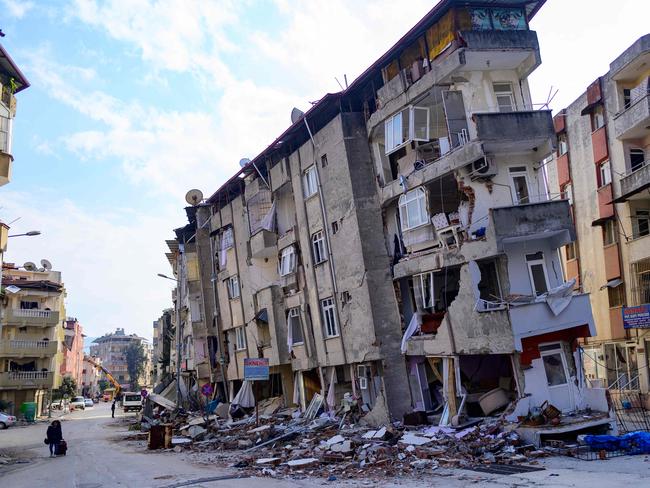

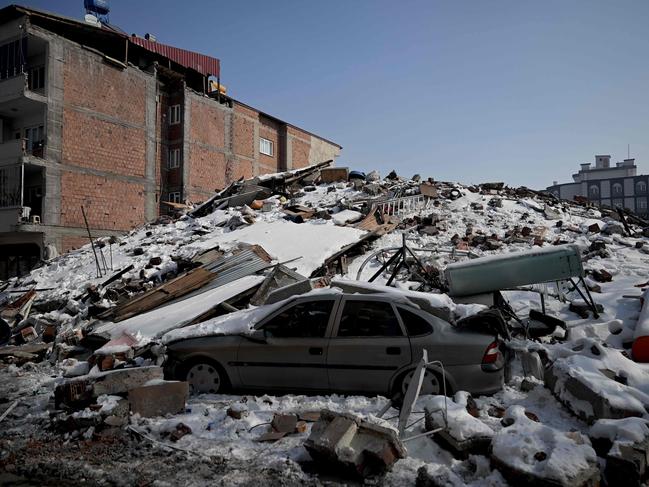
The close family friend remembered Mr Bayram as a standout dancer who was an introvert by nature.
“At our wedding, he was the centre of attention. He was an introverted person, but at the same time he loved to showcase things like that. He loved dancing,” she said.
Mr Bayram, who was holidaying in Turkey’s south with his nephew when the 7.8 magnitude earthquake struck on Monday, remained a central figure in Ms Weinman’s life, and those of his grandchildren.
“He used to take myself, his older son Jay and daughter Ebru to Turkish school every Saturday morning,” she said.
“He played a really huge part in our lives.
“He went there (Turkey) for a holiday and was playing with his grandchildren just two days before he left.”
Ms Weinman said the nature of Mr Bayman’s death overseas has made it difficult to honour Muslim burial customs, which often require the body of the deceased to be buried within 24 hours of their death.
Ms Weinman plans to fly to Melbourne in the coming days to support Mr Bayram’s family.

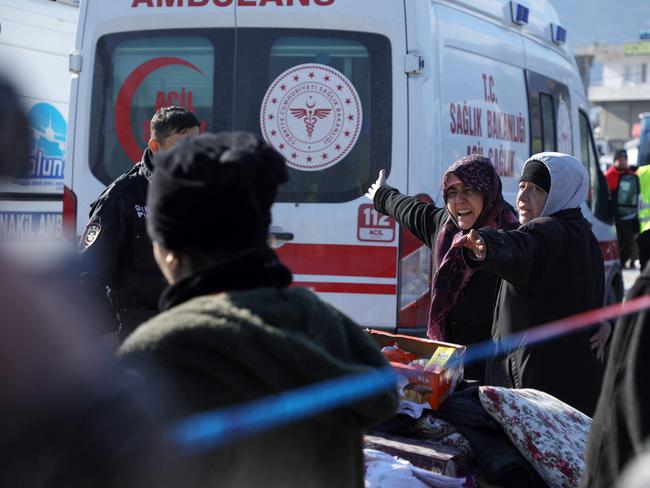
An Australian caught up in the catastrophic earthquake that hit Turkey and Syria earlier in the week is safe and accounted for, according to Foreign Minister Penny Wong.
It comes as rescuers pulled several people alive from the shattered remnants of buildings on Friday, some who survived more than 100 hours trapped under crushed concrete in the bitter cold after a catastrophic earthquake slammed Turkey and Syria.
The survivors included six relatives who huddled in a small pocket under the rubble, a teenager who drank his own urine to slake his thirst, and a four-year-old boy offered a jelly bean to calm him down as he was shimmied out.
Australian search and rescue experts have departed for the earthquake impact zones as part of a giant international aid effort.
Australia has sent 72 personnel and 22 tonnes of equipment including first aid supplies, tools, cameras, and sub-ground listening equipment to allow them to search for any possible survivors.
– with AFP
More Coverage
Originally published as Powerful earthquake turns Turkish olive grove into giant canyon




